|
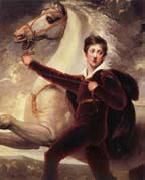 |
Thomas Stothard
|
|
English Neoclassical Painter, 1755-1834,English illustrator, painter and designer. He was one of the most popular, prolific and successful artists of his time and was highly regarded by such contemporaries as Thomas Lawrence and Walter Scott. He was the son of a prosperous publican and completed his apprenticeship as a silk weaver (1770-77), before studying at the Royal Academy, London (1777-c. 1783). From the beginning of his career, book illustration was his main area of activity. His earliest surviving works are in the decorative Rococo mode, but he soon adopted the more idealistic Neo-classicism of John Hamilton Mortimer and James Barry. Together with his friends and near contemporaries, William Blake and John Flaxman, Stothard developed an austere, linear style of draughtsmanship. |
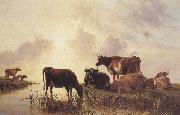 |
Thomas sidney cooper,R.A.
|
|
1803-1902
English painter. He was encouraged in his ambition to become an artist by Sir Thomas Lawrence and the animal painter Abraham Cooper (no relation; 1787-1868). He entered the Royal Academy Schools, London, in 1823. He subsequently taught art in Brussels where he met Eugene Verboeckhoven, whose work had a profound influence on him. Through Verboeckhoven he came to appreciate the work of such 17th-century Dutch painters as Aelbert Cuyp and Paulus Potter. In 1831 he returned to London, exhibiting at the Royal Society of British Artists. He exhibited 48 pictures at the British Institution between 1833 and 1863. The majority of his work was, however, exhibited at the Royal Academy; from 1833 to 1902 he exhibited 266 works there without a break, |
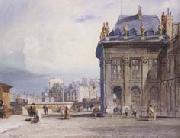 |
Thomas Shotter Boys
|
|
English Engraver, 1803-1874
English painter and printmaker. He was apprenticed on 4 February 1817 to George Cooke. His early training in engraving influenced his future career; his ability to draw a fine line, lay aquatint washes and hand-colour prints was an important factor in the creation of his particularly lucid style of watercolour landscapes and townscapes. At this time Cooke was engraving volumes of picturesque views by Turner and James Hakewell (1778-1843) as well as his own view of the Thames (1822); |
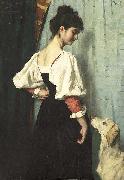 |
Therese Schwartze
|
|
(December 20, 1852, Amsterdam - December 23, 1918, Amsterdam) was a Dutch portrait painter.
Therese was the daughter of Johan Georg Schwartze (1814 - 1874), from whom she received her first training, before studying for a year under Gabriel Max and Franz von Lenbach in Munich. In 1879 she went to Paris to continue her studies under Jean-Jacques Henner. Her portraits are remarkable for excellent character drawing, breadth and vigour of handling and rich quality of pigment.
She was one of the few women painters who had been honoured by an invitation to contribute their portraits to the hall of painters at the Uffizi Gallery in Florence. Some of her best pictures, notably a portrait of Piet J Joubert, and Three Inmates of the Orphanage at Amsterdam, are at the Rijksmuseum, and one entitled The Orphan at the Boyman Museum in Rotterdam.
|
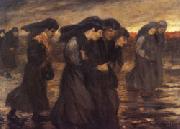 |
theophile-alexandre steinlen
|
|
Swiss-born French Art Nouveau Painter and Printmaker, 1859-1923
was a Swiss-born French Art Nouveau painter and printmaker. Born in Lausanne, Steinlen studied at the University of Lausanne before taking a job as a designer trainee at a textile mill in Mulhouse in eastern France. In his early twenties he was still developing his skills as a painter when he and his new wife were encouraged by the painter Francois Bocion to move to the artistic community in the Montmartre Quarter of Paris. Once there, Steinlen was befriended by the painter Adolphe Willette who introduced him the artistic crowd at Le Chat Noir that led to his commissions to do poster art for the cabaret owner/entertainer, Aristide Bruant and other commercial enterprises. La tournee du Chat Noir avec Rodolphe Salis (1896)In the early 1890s, Steinlen's paintings of rural landscapes, flowers, and nudes were being shown at the Salon des Independants. His 1895 lithograph titled Les Chanteurs des Rues was the frontispiece to a work entitled Chansons de Montmartre published by Editions Flammarion with sixteen original lithographs that illustrated the Belle Epoque songs of Paul Delmet. His permanent home, Montmartre and its environs was a favorite subject throughout Steinlen's life and he often painted scenes of some of the harsher aspects of life in the area. In addition to paintings and drawings, he also did sculpture on a limited basis, most notably figures of cats that he had great affection for as seen in many of his paintings. Steinlen became a regular contributor to Le Rire and Gil Blas magazines plus numerous other publications including L'Assiette au Beurre and Les Humouristes, a short-lived magazine he and a dozen other artists jointly founded in 1911. |
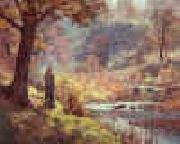 |
Theodore Clement Steele
|
|
1847-1926
Theodore Clement Steele Galleries
Theodore Clement Steele (September 11, 1847-July 24, 1926) was an American Impressionist painter known for his Indiana landscapes. Steele was born in Owen County, Indiana, and later moved to Indianapolis after study in Cincinnati, Chicago and Munich. He is considered to be the most important of the Hoosier Group of painters and his work is widely collected by museums and individuals. Steele earned his living primarily as a portrait painter and his portraits include one of notable Hoosier Poet James Whitcomb Riley and the official portraits of several Indiana governors. Steele exhibited at and was on the art selection for the Louisiana Purchase Exposition in 1904 and was elected to the National Academy of Design in 1913. He enjoyed plein air, or outdoor, painting, which is reflected in many of the landscapes he painted. Steele went through a notable change in style after his return from Munich in 1885. Steele's work, which in the Munich time period sported drab colors and high contrasts, shifted towards a brighter, more vivid color palette after his return to Indiana. Upon T.C. Steele's return, his family lived in the Talbot House, or Tinker Mansion, which is at what is now 16th and Pennsylvania Streets in Indianapolis. In 1898, Steele and J. Ottis Adams bought a home in Brookville, Indiana, which they called "The Hermitage." Steele sold his interest in the home to Adams after the death of his first wife.
He received an honorary master's degree from Wabash College in 1900 and an honorary doctorate from Indiana University in 1916. |
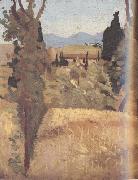 |
Telemaco signorini
|
|
Italian Painter, 1835-1901
was an Italian artist who belonged to the group known as the Macchiaioli. He was born in the Santa Croce quarter of Florence, and showed an early inclination toward the study of literature, but with the encouragement of his father, Giovanni Signorini, a court painter for the Grand Duke of Tuscany, he decided instead to study painting. In 1852 he enrolled at the Florentine Academy, and by 1854 he was painting landscapes en plein air. The following year he exhibited for the first time, showing paintings inspired by the works of Walter Scott and Machiavelli at the Florentine Promotrice. In 1855, he began frequenting the Caffe Michelangiolo in Florence, where he met Giovanni Fattori, Silvestro Lega, and several other Tuscan artists who would soon be dubbed the Macchiaioli. The Macchiaioli, dissatisfied with the antiquated conventions taught by the Italian academies of art, started painting outdoors in order to capture natural light, shade, and color. They were forerunners of the Impressionists who, beginning in the 1860s, would pursue similar aims in France. Signorini was a volunteer in the Second Italian War of Independence in 1859, and afterwards painted military scenes which he exhibited in 1860 and 1861. He made his first trip outside Italy in 1861 when he visited Paris, to which he would often return in the decades that followed. There he met Degas and a group of expatriate Italian artists in his orbit, including Giovanni Boldini, Giuseppe De Nittis, and Federico Zandomeneghi; unlike them, however, Signorini remained rooted in Italy. He became not only one of the leading painters of the Macchiaioli, but also their leading polemicist. Art historian Giuliano Matteucci has written: "If we acknowledge Fattori and Lega as the major creative figures of the macchiaioli, then Signorini must surely be recognized as their 'deus ex machina'", |
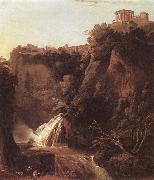 |
Sylvester Shchedrin
|
|
1791-1830,was a Russian landscape painter. Sylvestr Shchedrin was born in St. Petersburg into the family of the famous sculptor Pheodosiy Shchedrin, rector of the Imperial Academy of Arts. The landscape painter, Semion Shchedrin, was his uncle. In 1800, Sylvester Shchedrin entered the Imperial Academy of Arts in St. Petersburg, where he studied landscape painting. Among his teachers were his uncle, Semion Shchedrin, Fedor Alekseev, M.M. Ivanov and Thomas de Thomon.[1]. In 1811e graduated with several awards including the Large Gold Medal for his painting View from Petrovsky Island that gave him a scholarship to study abroad. Lake of Albano, 1825Sylvester left for Italy in 1818, delayed due to the Napoleonic Wars. In Italy, he studied the old masters in Rome; goes to Naples to paint watacolrs ordered by Grand Duke Mikhail Pavlovich of Russia; then return back to Rome. The biggest achievement of that period was New Rome. castle Sant'Angelo (1823) It was such a great success that he has painted 8..10 variations of the painting, each from a slightly different angle and with different details. His pension ended in 1823, but he decided to stay in abroad as a freelance painter. In 1825 he finished his work Lake of Albano that was a new step in his movement to the natural composition. In this painting he relaxed the boundary between subject and background, moved from using the formal colors. Shchedrin had many commissions and grew to become a well-known artist in Italy. He lived in Rome and Naples, working en plein air, drawing bays and cliffs and views of small towns and fishermen villages. One of his favorite motifs were terraces in vines with a view of the sea. Referred as the images of the "Midday Paradis".At the end of the 1820s, Shchedrin began to draw nighttime uneasy, almost nightmarish landscapes, which may have been inspired from his gradually declining health. He died in Sorrento in 1830. |
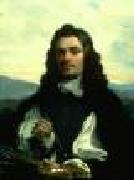 |
SWEERTS, Michiel
|
|
Flemish Baroque Era Painter, ca.1618-1664
Flemish painter, active in Italy, Syria and India. He arrived in Rome in the mid-1640s, perhaps in circumstances similar to those depicted in his painting The Landing (Paris, Louvre). In 1646 he was registered as living in the Via Margutta in the parish of S Maria del Popolo, where documents indicate that he continued to reside until 1651, together with other Flemish Catholics like himself. In 1647 he attended a meeting of the Accademia di S Luca, not as an academician but simply as an associate. The following year he was visited by the Dutch poet Matthijs van de Merwede (1625-?1677), who later recalled the extremely poor welcome he received from the artist. On 1 June 1651 Sweerts was employed by the Antwerp merchant Jan Deutz to represent him at the Papal Customs to collect seven pieces of woollen cloth from Leiden. Sweerts's relationship with the Deutz family was always close: he painted portraits of Jeronimus Deutz (Amsterdam, Rijksmus.) and Balthasar Deutz and a series of the Seven Acts of Mercy for the family; some scholars have identified this series with the cycle of paintings divided between the Rijksmuseum, Amsterdam, the Wadsworth Atheneum, Hartford, CT, and two private collections |
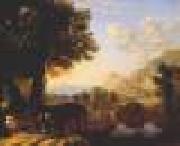 |
SWANEVELT, Herman van
|
|
Dutch Baroque Era Painter, ca.1600-1655
Dutch painter, draughtsman and etcher, active in France and Italy. His first signed and dated works are two views of Paris dated 1623 (Brunswick, Herzog Anton Ulrich-Mus.). He was in Rome from 1629 to 1641. His earliest dated painting there is an Old Testament Scene (1630; The Hague, Mus. Bredius; see fig.), a compositional formula that he often used, with some variations, in Rome. A flat, low foreground is closed on the left by a house and a tree; on the right is a distant hilly scene; and groups of figures are disposed horizontally. This design, derived from Cornelis van Poelenburch, is well suited to van Swanevelt's many landscapes with biblical and mythological subjects. The large tree extending beyond the frame gives a monumental touch to the composition. |
 |
swabian school
|
|
the lovers
1470
the cleveland museum of art, delia and l.e. holden funds |
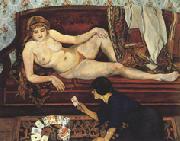 |
Suzanne Valadon
|
|
French Post-Impressionist Painter, 1865-1938
French painter and artist's model. She led a lonely childhood in Paris as the daughter of an unmarried and unaffectionate maid, seeking refuge from her bleak circumstances by living in a dream world. While residing in the Montmartre district of Paris, she became an artist's model, working in particular with those painters who frequented the Lapin Agile. From 1880 to 1887, for example, she sat regularly for Pierre Puvis de Chavannes, posing for both the male and female figures in the Sacred Wood (1884-6; Lyon, Mus. B.-A.). She also modelled for Renoir, Luigi Zandomeneghi, Th?ophile Steinlein, Jean-Louis Forain, Giuseppe De Nittis and Jean-Jacques Henner. No longer able to tolerate the passive role of the model, |
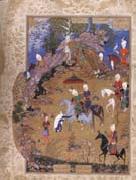 |
Sultan Muhammad
|
|
Persian Painter, active ca.1505-1550
Persian illustrator. He was apparently a native of Tabriz and spent most of his life there. Contemporary sources suggest that he was at the height of his creative powers in the 1520s and 1530s when he was one of the leading painters in the employ of the Safavid shah Tahmasp. Sultan-Muhammad's documented paintings include contributions to a monumental copy (dispersed, ex-Houghton priv. col.) of Firdawsi's Shahnama ('Book of kings') made for Tahmasp between c. 1524 and c. 1529 and paintings from a copy (divided, New York, Met. and Cambridge, MA, Sackler Mus.) of Hafiz's Divan (collected poems), probably executed between 1531 and 1533. Sultan-Muhammad's paintings for these manuscripts demonstrate how the tradition of western Iranian painting as practised in Tabriz, Shiraz and other centres during the 15th century continued to be significant at the Safavid court . |
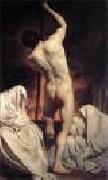 |
SUBLEYRAS, Pierre
|
|
French Painter, 1699-1749
was a French painter, active during the late-Baroque and early-Neoclassic period, mainly in Italy. Subleyras was born in Saint-Gilles-du-Gard, France. He left France in 1728, having carried off the French Academy's grand prix, which carried scholarship for study in Rome. In Rome, he painted for the Elector of Saxony, Frederick Christian, a "Christ's Visit to the House of Simon the Pharisee" , (later engraved by Subleyras himself), this work procured his admission into the famed Roman artists guild, Accademia di San Luca. Cardinal Valenti Gonzaga next obtained for him the order for Saint Basil & Emperor Valens (also known as the Mass of St. Basil , which was executed in mosaic for St Peter's. Another masterpiece is his painting of St. Camillo De Lellis coming to the rescue of the diseased at the hospital of the Holy Spirit He was a remarkably incisive portraitist, as evident from the portrait of Pope Benedict XIV or of the obese Cardinal Valenti Gonzaga . The pope himself commanded two great paintings, the "Marriage of St Catherine" and the "Ecstasy of St Camilla", which he placed in his own private apartments. Subleyras shows greater individuality in his curious genre pictures, which he produced in considerable number (Louvre). |
 |
STUBBS, George
|
|
English Romantic Painter, 1724-1806
English painter, draughtsman and printmaker. His study of anatomy enabled him to paint horses, dogs and wild animals with unsurpassed truth to nature, while his innate sense of design enabled him to achieve graceful, rhythmic compositions. His contemporary reputation was chiefly based on portraits of horses and dogs; but he also painted human portraits, conversation pieces and imaginative subjects with animals. |
 |
STRIGEL, Hans II
|
|
German painter, Swabian school (active 1450-1480 in Memmingen). Painter. The panels of the Montfort-Werdenberg Altarpiece and a Deposition mural (1477), fragment of a series in the church at Tiefenbach, Allgäu, are documented as his. They show an artist in the tradition of Hans Multscher, using strongly foreshortened perspectives for an emphatic relaying of realities. In the 1470s he attempted to tone down the contrasts, to organize his figures after the manner of the Master of Sterzing: a change of style shown in the panels of the Mickhausener altar (Budapest, Mus. F.A.) and the Saints and Passion scenes in the Oberhaus-Museum |
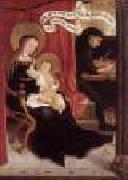 |
STRIGEL, Bernhard
|
|
German Northern Renaissance Painter, ca.1460-1528..Painter, son or nephew of Hans Strigel II. His training with Hans Striegel II shows stylistically in his early works in the Grisons, e.g. the Last Judgement (1486; Brigels, pilgrimage chapel of St Eusebius) and an altarpiece at Disentis (1489; St Johann Baptist). In the 1480s and 1490s he also worked in the studio of Ivo Strigel. Motifs in his pictures stem from engravings by Martin Schongauer and from Ulm book woodcuts. He met Bartholomus Zeitblom as a fellow worker on the high altar (1493-4) of Blaubeuren Abbey, both being influenced by Netherlandish art: Zeitblom by Rogier van der Weyden but Strigel primarily by Dieric Bouts. This influence is also seen in his Adoration of the Magi altarpiece (c. 1500; Memmingen, Stedtmus.). The altar of the Virgin for the monastery at Salem (1507-8; Salem, Schloss) has links with D?rer's graphic work: an increasing three-dimensionality and monumentalization of the objects and figures, and their disposition in space. |
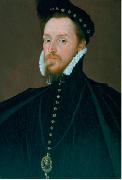 |
Steven van Herwijck
|
|
(Utrecht c. 1530-London 1565/67), was a Netherlandish sculptor and gem engraver famous for his portrait medallions and medals. It has recently been suggested that he is the "famous paynter Steven" mentioned in an inventory of 1590, who has traditionally been identified as Steven van der Meulen.
Van Herwijck worked in Italy in 1557 and returned to Utrecht in 1558, when he was made a Master of the artists' Guild of St. Luke. His earliest surviving medals, of George van Egmond, Bishop of Utrecht, and Engelken Tols, date from this year. In 1559 he relocated to Antwerp. Nine medals survive of his work there, including a portrait of Jacobus Fabius. Fleeing religious persecution, he went to Poland in 1561 where he made medallions of King Sigismund II and other members of the Polish royal family. |
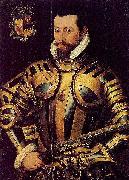 |
Steven van der Meulen
|
|
(b. eAntwerp - d. London, e1563-64) was a Dutch artist active c. 1543-1564. He gained prominence in England in the first decade of the reign of Elizabeth I as one of many Flemish artists active at the Tudor court. He is best known for the "Barrington Park" portrait type of Elizabeth I and for three-quarter length portraits of members of the English court in the first half of the 1560s. A recently discovered will indicates that he died in London between October 1563 and January 1564.
|
 |
Stephen Pearce
|
|
(London, 1819-904) was a portrait and equestrian painter. Forty-four portraits which he painted are in the National Portrait Gallery in London, which also contains two self-portraits.
|
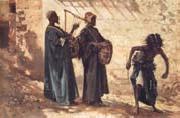 |
Stefano Ussi
|
|
Italian, 1822-1901,Italian painter. He received his formal training at the Accademia delle Belle Arti in Florence (1837-50, expelled 1838-40) under Tommaso Gazzarini (1790-1853), Pietro Benvenuti and Giuseppe Bezzuoli. In 1854 he won a scholarship to study in Rome and for several years worked on the large-scale painting that established his reputation, the Expulsion of the Duke of Athens from Florence |
 |
Stefano Torelli
|
|
Bologna 1712-St Petersburg 1784
was an Italian painter. He was born in Bologna. He studied first under his father, Felice Torelli, and then under Francesco Solimena. The future King of Poland, Augustus III, brought him to Dresden in 1740, where he painted altar-pieces and ceiling decorations, many destroyed in the Seven Years' War. He painted figures in Canaletto's twenty-nine views of Dresden (1741). In 1762 he was summoned to the Russian court where he painted ceilings in the Royal Palace, and some portraits, among the latter one of the Empress Elizabeth in armor. He was a clever caricaturist, and etched a few plates. He died in St. Petersburg. |
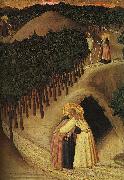 |
Stefano di Giovanni Sassetta
|
|
1423-1451
Italian
Stefano di Giovanni Sassetta Gallery
Stefano di Giovanni, known as il Sassetta, (Siena 1392 ?C 1450 or 1451) was an Italian painter. He was born in Siena, although there is also an hypothesis that he was born in Cortona. However, the first historical record of him was in Siena in 1423. Di Giovanni was probably the apprentice of Paolo di Giovanni Fei although it is also thought that he may have studied under Benedetto di Bindo. He painted in the semi-archaic Sienese School style of painting. Francesco di Giorgio e di Lorenzo, better known as Vecchietta, is said to have been his apprentice. |
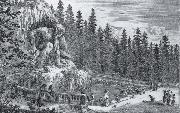 |
Stefano della Bella
|
|
Italian Baroque Era Printmaker, 1610-1664,was an Italian printmaker known for etchings of many subjects, including military ones. He was born at Florence, and apprenticed initially to a goldsmith, but became an engraver working under Orazio Vanni and then Cesare Dandini. He studied etching under Remigio Cantagallina, who had also been the instructor of Jacques Callot, who had lived in Florence 1612-1621, and whose prints imparted a strong influence to printmakers. The patronage of Don Lorenzo de Medici enabled della Bella to study for three years in Rome. In Rome, he created a then admired print of the cavalcade celebrating the entry of the Polish ambassador into Rome in 1633. He also created a number of prints of views of Rome. In 1642 he went to Paris, introduced by the Tuscan ambassador, Alessandro del Nero, and where he resided for seven years. Cardinal Richelieu engaged him to go to Arras and make drawings of the siege and taking of that town by the royal army. After residing a considerable time at Paris he returned to Florence, where he obtained a pension from the grand duke, whose son, Cosimo de Medici, he instructed in drawing. His productions were very numerous, amounting to over 1000 separate pieces. He is known to have illustrated some discoveries for Galileo. See entry for Hansken for his etching of the famous elephant after death. Wikimedia Commons has media related to: Stefano della Bella |
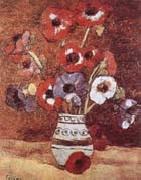 |
Stefan Luchian
|
|
Romanian Painter, 1868-1916
Romanian painter. He studied at the School of Fine Arts in Bucharest, graduating in 1889 and continuing his studies at the Akademie der Bildenden Kenste in Munich and in Paris at the Academie Julian, where he was a student of William-Adolphe Bouguereau. He rejected the rigidity of academic painting early in his career, however. The Last Autumn Race (1892; Bucharest, Mus. A.), one of the few paintings known from this period, clearly illustrates the influence of Manet and Impressionism on his early work. On his return to Romania in 1892 Luchian, unwilling to restrict his work to merely copying the French artists, struggled to create an original style. In 1900 he was left partially paralysed by a spinal disease, but he continued to work, and it is during the next years that he created his most accomplished works. His self-portraits (e.g. 1907; Bucharest, Mus. A.) are clear evidence of his determination to overcome this personal tragedy; far from inspiring pity, these paintings emphasize the depth and the strength of his inner life. It is in landscapes such as Willows at Chiajna (c. 1907; Cluj-Napoca, Mus. A.), however, that his commitment becomes even more apparent, with joyful rhythms created by means of broad brushstrokes and contrasts of bright colours next to delicate tones. Towards the end of his life Luchian became completely immobilized. During this time flowers were his favourite subject (e.g. Safta, the Flower Girl; Bucharest, N. Mus. A.; see also ROMANIA, fig. 9), and they became a metaphorical bridge between the artist and the outside world. The colours are still bright in these last paintings, and the loss of pastel tones makes the contrast more dramatic. |
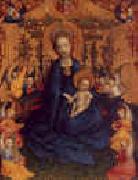 |
Stefan Lochner
|
|
German painter (b. ca. 1400, Meersburg am Bodensee, d. 1451, Köln
was a German late Gothic painter.
His style, famous for its clean appearance, combined Gothic attention towards long flowing lines with brilliant colours with a Flemish influenced realism and attention to detail.
He worked mainly in Cologne, Germany, and his principal work is the triptych of the Altar of the City Patrons (done in the 1440s, which is in the Cologne Cathedral), which represents the city in homage to the infant Jesus. The epitome of his style is Madonna of the Rose Bower (c. 1450, housed in the Wallraf-Richartz Museum in Cologne), showing the Virgin and Child reposing in a blooming rose arbor and attended by Lochner's characteristic child Angels. |
 |
stefan Dimitrescu
|
|
(January 18, 1886 - May 22, 1933) was a Romanian Post-impressionist painter and draftsman.
Born in Huşi into a modest family, he completed his primary and secondary studies in his hometown. In 1902, deciding to follow his passion for music, he left for Iaşi, where he took cello classes at the Iaşi Conservatory.
In summer of 1903, Dimitrescu entered the National School of Fine Arts in the city, studying in the same class as Nicolae Tonitza; the two studied under Gheorghe Popovici and Emanoil Bardasare. After graduation, Dimitrescu painted murals for the Orthodox churches in Agăş and Asău (Bacău County). |
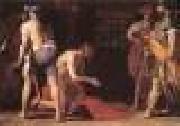 |
STANZIONE, Massimo
|
|
Italian Baroque Era Painter, 1585-1656
Italian painter. Primarily a painter of altarpieces and frescoes, his large production and vast following of students and imitators made him perhaps the leading Neapolitan painter in the first half of the 17th century. He was known as the great rival of Jusepe de Ribera, and for most of the 1630s and 1640s he and Ribera dominated painting in Naples. Stanzione's rich colour and idealized naturalism, for which he was called 'il Guido Reni napoletano', definitively influenced numerous local artists and remained discernible in the earliest works (1670s) of Francesco Solimena. Only a few portraits and mythological paintings by Stanzione are known, |
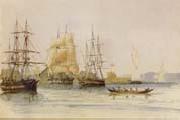 |
Stanley, Owen
|
|
1811 - 1850,was commander of HMS Rattlesnake on a four year exploratory expedition to New Guinea, 1846?C1850. Stanley was the son of Edward Stanley, Bishop of Norwich. He left naval college at the age of fifteen, and served under Phillip Parker King on HMS Adventure and John Franklin in the Mediterranean. In 1836 he sailed to the Arctic as scientific officer on HMS Terror under George Back. In 1838 he was given command of HMS Britomart and sailed to Australia, returning in 1843. In December 1846 Stanley sailed from Portsmouth in charge of HMS Rattlesnake, with the purpose of surveying the seas around the Great Barrier Reef and Torres Strait. The ship called at Madeira, Rio de Janeiro, Simon's Town and Mauritius, arriving in Sydney in July 1847. |
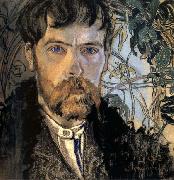 |
Stanislaw Wyspianski
|
|
1869-1907
was a Polish playwright, painter and poet, as well as interior and furniture designer. A patriotic writer, he created a series of symbolic, national dramas within the artistic philosophy of the Young Poland Movement. Wyspiaeski was one of the most outstanding and multifaceted artists of his time in Europe. He successfully joined the trends of modernism with themes of the Polish folk tradition and Romantic history. Unofficially, he came to be known as the Fourth Polish Bard. Stanisław Wyspiaeski was born to Franciszek Wyspiaeski and Maria Rogowska. His father, a sculptor, owned an atelier on Wawel Hill. His mother died of tuberculosis in 1876 when Stanisław was seven years old. Due to alcohol problem, Stanisław's father could not fulfil his parental responsibilities. Stanisław was adopted by his aunt Joanna Stankiewiczowa and her husband Kazimierz. The Stankiewicz family belonged to a bourgeois and intellectual class. In their house Wyspiaeski became acquainted with painter Jan Matejko, who was a frequent visitor. Matejko soon recognized that the boy had artistic talent and gave him the first artistic guidance. Wyspiaeski attended Saint Anne's Secondary. The school was unique for several reasons. Firstly, although Polish language was forbidden in educational institutions under foreign rule, the lectures in Saint Anne's Gymnasium were delivered in Polish. Secondly, the teacher's goal was to equip the students with a thorough knowledge of Polish history and literature. Thirdly, the school graduates, which included Lucjan Rydel, Stanisław Estreicher and Henryk Opieeski, were considered prominent figures in Krakew's cultural life. As a student Wyspiaeski did not display any specific talent, but took particular interest in art and literature. According to Joanna Stankiewiczowa, a young Stanisław portrayed small village cottages, animals, plants, armors and decorations. As far as literature was concerned, Wyspiaeski created a dramatic interpretation of Matejko's painting Stefan Batory pod Pskowem (Bathory at Pskov). In 1887 Wyspiaeski enrolled in the Philosophy Department at the Jagiellonian University and the School of Fine Arts in Krakew. While studying at the University, he attended lectures in art, history and literature. Jan Matejko, the dean of the School of Fine Arts soon recognized Wyspiaeski's talent and asked him to join in the creation of a polychrome inside the Mariacki Church. The years 1890-1895 were devoted to traveling. Wyspiaeski visited Italy, Switzerland, Germany, Prague and France. The stay in France was regarded to be the major point in his artistic life. He studied at the private atelier Academie Colarossi. Since the school fee was very high, Wyspiaeski applied for a grant. During the stay in France he got acquainted with Paul Gauguin. Together they visited art museums, where Wyspiaeski was bewitched by the beauty of Pierre Puvis de Chavannes's paintings. He also attended theatre performances based on Shakespeare's and antic plays. His future dramas: Daniel i Meleager (Daniel and Meleagra) and Powret Odysa (Return of Odysseus) were based on the antic tradition. Meanwhile, he worked on several dramas Krelowa Polskiej Korony (The Queen of Polish Crown), Warszawianka (Varsovian Anthem) and the first version of Legenda (Legend). The play Legenda (Legend) was based on the famous Polish legend about Wars and Sawa. In August 1894 he returned to Krakew, where he got involved in the modernist movement. It was then he designed and partially made a polychrome for the Franciscan Church that was composed of flowery, geometrical and heraldic motifs. Moreover, the prior of the church encouraged Wyspiaeski to design various stained glass windows such as Blessed Salomea, Saint Francis Stigmata and God the Father. It is worth mentioning that Wyspiaeski received an award of the Polish Academy of Learning for the landscape of the Kopiec Kościuszki (Kościuszko Mound). |
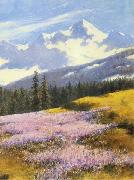 |
Stanislaw Witkiewicz
|
|
(8 May 1851 in Pašiaušė - 5 September 1915 in Lovran) was a Polish painter, architect, writer and art theoretician.
Witkiewicz was born in the Lithuanian village of Pašiaušė (Polish: Poszawsze) in Samogitia, at that time, in the partitioned Polish-Lithuanian Commonwealth lands ruled by the Russian Empire.
Witkiewicz studied in Saint Petersburg, 1869-71, then in Munich, 1872-75.
He created the Zakopane Style (styl zakopiaki) (also known as Witkiewicz Style (styl witkiewiczowski)) in architecture. He was strongly associated with Zakopane and promoted it in the art community.
His son, Stanisław Ignacy Witkiewicz, became a famous painter, playwright, novelist and philosopher, also known (from the conflation of his surname and middle name) by the mononymous pseudonym "Witkacy." The son's godmother was the internationally famous actress Helena Modjeska (Helena Modrzejewska), whom the elder Witkiewicz in 1876 had nearly accompanied to California in the United States.
Witkiewicz had strong views against formal education: "school is completely at odds with the psychological make-up of human beings". He applied this principle in his son's upbringing and was disappointed when the 20-year-old Witkacy chose to enroll at the Academy of Fine Arts in Krakew.
In 1908, suffering from tuberculosis, the elder Witkiewicz left his family in Zakopane and relocated to Lovranno, a fashionable resort in what was then Austria-Hungary, which today is in Croatia. He died there in 1915.
|
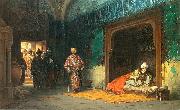 |
Stanislaw Chlebowski
|
|
(1835-1884) was a Polish painter with Russian and Turkish connections. He was a renowned specialist in oriental themes.
Chlebowski was born in Podole, and learned drawing in Odessa. Between 1853-1859, he studied at the Academy of Fine Arts in St. Petersburg, and then on a scholarship for six years in Paris as the pupil of the French orientalist painter Jean-Leon Gerôme. Chlebowski traveled to Spain, Italy, Germany, and Belgium. His first success was selling his painting "Joanne deArc in Amiens prisone to Napoleon III of France
In the years 1864-1876 Chlebowski was master painter for Sultan Abdelaziz and took up residence in Constantinople. Chlebowski became popular with the Sultanate. During his services, he had obtained permission to bring with him a large Icon of Mother of God Leading our Way having been rescued from a Odegon Monastry in 1453. He had come across it in one of the magasins with old relics, unheeded by the Ottoman keeper. This account is certified in a letter by Comite National Polonais a Constantinople, dated June 27, 1938.
In 1876 he moved to Paris. In 1881 he returned permanently to Krakow. The subject matter of his watercolors and oil paintings is diverse. He painted images of historical battles related to the history of Turkey, oriental genre scenes, landscapes, and portraits of Sultans. He died near Poznae in Kowanewko at age 49.
Chlebowski lived abroad for a long time and as a result his paintings were very rare in Poland. The National Museum in Krakow houses some of his other important Orientalist works such as "Entree de Mahomet II e Stamboul".
|
|

